Iberostar, Dressel Divers, Cozumel and Playa del CarmenContents of this Issue: Iberostar, Dressel Divers, Cozumel and Playa del Carmen Quino del Guardián, Sea of Cortés, Mexico Head/Mares Discovers the Reason for Full Face Mask Deaths A Row Erupts Over a Great White Shark’s Death Climate Change is Killing Clownfish The Rich Sounds of Healthy Reefs May Save Them Harrowing Tales from the Red Sea Aggressor I Fire Lithium-ion Battery Safety: Industry Experts Give Their Points of View U.S. Coast Guard Regulations under Criticism in Wake of the Conception Tragedy A Taste of the DEMA Show November 2019 Editorial Office: Ben Davison Publisher and Editor Undercurrent 3020 Bridgeway, Suite 102 Sausalito, CA 94965 the one-week trifecta: reefs, cenotes, whale sharks from the January, 2020 issue of Undercurrent
Dear Fellow Diver, Having been to Cozumel enough times over 30 years, I had little interest in returning, until friends suggested I join a unique group trip: three days of Cozumel drift diving, three days in Playa del Carmen to dive cenotes, then a snorkel with whale sharks north of Cancun. All in a single week, led by a single dive operator, Dressel Divers, while staying at two luxury Iberostar hotels. I signed up for the July trip.
On the boats, some of us received half-empty cylinders, and replacing them resulted in delayed boat departures. But the crew was competent and courteous, and our two divemasters, Omar and Anna, were nearly perfect. Keeping a dozen divers together during drift dives showed that they were capable of "herding cats," as they say. Our boat, the Palancar Diver, was a 35-foot inboard with limited sun shading, a camera rinse tank, fresh fruit, and ship to shore communication, but no head, not much of a problem as they usually returned to the dock (and rest rooms) between dives. Francisco, the boatman, helped divers and lifted heavy BCs in and out of the water. The sea was calm and water 82°-84°. Undercurrent has plenty of dive descriptions in readers reports and past articles, so I'll just mention a couple: the first, La Francesca, a short ride from the Iberostar dock. My group and I dropped into 150-foot visibility at the south end and drifted along at almost two knots for a half a mile in 30 to 40 feet of water, passing dense stands of beautiful and healthy encrusting corals and sponges, home to myriads of reef fish, especially schools of French and blue-stripe grunts. Green morays hid under overhangs; Townsend and French angels, blue tangs and blue runners mixed in with myriads of juveniles and small-fry. Two large loggerheads drifted along. Nice dive, indeed. Drift diving in Cozumel is fun and intuitively easy to master. Just stay near your buddy and try to stay with the divemaster. If you get ahead of the group, duck down behind a high spot on the reef, in an eddy, and they will catch up. A surface marker buoy is mandatory, which helps you get picked up if you get separated. Columbia Wall has been a world-class dive site, but Cozumel has been so heavily dived that much of the coral is damaged. There are essentially no sea fans, and little remains of fragile tube sponges. Despite this, majestic coral pillars swept by the current rise 20-30 feet above the clear white sand. Friendly hawksbill and loggerhead turtles are frequent visitors; one swam through our group right up to my camera. Schools of horse-eyed jacks cruised between the coral pillars, with black grouper, oceanic triggerfish, queen triggers and pompano abounding. In swim-thrus that seemed to go in all directions, channel crabs tucked themselves into recesses. We stayed about 50 feet deep, but over the wall, one could go down forever.
The Iberostar is an all-inclusive hotel with all the food and free watereddown booze you could consume. The buffet offers an astounding 200 freshly prepared and delicious selections at each meal, which definitely had a Mexican orientation. Everything was excellent. The wooded and landscaped jungle-like hotel grounds (about 100 acres) are traversed with paved footpaths and frequented by coatimundis, agoutis, peacocks, and other wildlife. The 306 clean and simple airconditioned rooms are housed in several dozen separate, round thatched-roof buildings and have strong wifi, solar hot water, and a fridge with bottled water. Two large pools are on the complex, as well as several restaurants. Both here and in Playa del Carmen, the Iberostar featured surprisingly talented singers and musicians performing the great rock and roll songs. It was quite a party. Because of boat traffic, one should not snorkel or swim in front of the resort, except in the roped-off area. The small sand beach turns into sharp iron-shore at water's edge. For snorkelers, there was a roped-off area filled with hundreds of reef fish looking for handouts.
On Wednesday, we headed to Playa del Carmen; all transportation and the 12-mile ferry cruise was arranged in the package set up by Caradonna Dive Travel. It took up most of the day, but we landed at another fine Iberostar, but with no shore diving available. Dressel drove some shore divers down the coast to their shop. The Tucan has some 20 three-story buildings, but without elevators, so dragging dive equipment up and down from the third floor could be an issue; a prompt bellhop and a $2 tip solved the problem. The grounds had similar amenities of Cozumel, with more acreage and even some jungle canopy left, where howler monkeys screamed, and once they even raided a nearby balcony and purloined food. The Tucan has a beautiful world-class, 300-yard-wide white sand beach with 100 palm-thatched palapas, a small cafeteria near the beach, and showers. Inland they feature an enormous freshwater pool, a lap pool, and a secluded pool in the forest with a swim-up bar where the serious drinking occurs. It's a huge buffet for all meals, though there are five other restaurants, including a Japanese restaurant with an extensive sushi menu. The buffet routinely provided several different ceviches: fish, octopus, mussel, clam, calamari and with choices of different seasonings. Looking at buffet offerings, I came up with 381 appetizers, entrees and desserts for a typical meal.
Dressel Divers was better organized here than in Cozumel, having had our registration forms transferred from Cozumel. Paul Flowers, the manager, sat everyone down and asked what rental equipment or weights they needed and saw to it they were provided. Cenotes (pronounced say NO tay) are essentially fresh-water caves and caverns, and the deepest we got was only 45 feet for an hour. The guides were certified cave divers, as well as instructors or divemasters, and they clearly presented their detailed cavern diving rules. There were no requirements other than one had to be a certified diver. The diving was cavern diving -- not cave diving -- and we could (supposedly) always see an opening or light to the surface: "it will be visible at all times." "Sometimes" would be more accurate. Frequently the light was a couple hundred feet away and only a faint glow, if it could be seen at all.
They divided us into groups of four, and the divemaster reviewed, again, the use of frog kicks, high fin kicks and spacing between divers. Our skilled divemaster for this Cenote was a woman named Yuremi, from Argentina, who had divemaster experience all over the world. Those with the least experience were put closer to the guide, who led. If you were to get too close to the diver in front and get your mask kicked off, we were told it was your fault, not that of the diver in front of you. The cave diver's "rule of thirds" was carefully explained: one-third of your air for the trip in, the second third for the return, and last third for reserve. We all surfaced with about 1500 psi after 45-50 minutes. Everyone carried a light, not only to see the environment and where they're going, but so the divemaster could easily count her flock. I once turned off my marker light and then turned off my video floods to get still shots of divers with lights. I thought that was pretty cool until our divemaster stopped the parade and came back to scold me, appropriately so. Chikin-Ha cenote dive consists of about 45 minutes of overhead environment in 77-degree fresh water with 200-foot visibility. In the parking lot, we geared up at tables and benches under a thatched hut and then walked 100 yards down a rough path to where steps led down into the water. We slowly finned through a series of beautiful chambers for almost 300 yards. There is a line attached to various projections that you keep in sight. Some chambers I estimated to be 100 feet wide, with huge rock formations. In some beautiful sections, sunlight streamed in from an opening above, illuminating structures and producing unique visual contrasts. One structure, named Twin Dogs because some say that's what it looked like, to me looked more like a Mayan god ... Perhaps Xibalba, the Mayan god of the underworld itself. Finally, we returned to the original entry and walked back to the parking lot, where there is a restroom; we were handed bottled water and chicken sandwiches. The Chac-Mool cenote had been an open and air-filled cave long enough to form stalactites and stalagmites before flooding thousands of years ago when sea levels rose after the last Ice Age. There were piles of stalactites on the floor, having fallen when sections of the collapsed ceiling. A few stalagmites still protruded up from the floor. No cameras are allowed. Marcello, our divemaster, informed us that someone carrying a large camera and not paying attention crashed into a stalagmite and damaged it. Thereafter, the property owner mandated no more cameras! The halocline was deep enough that my dive buddy and I could actually dip below it and swim in the warmer, denser saltwater below. We were later led into an air dome with a water level a few feet below the roof of the sealed chamber. Huge roots from the forest above extended from the ceiling to the water to lap it up. I saw a few cave fish, one a type of Mexican cave tetra, about 4 inches long with the classic tetra shape and listed in cave fish books. Another had whiskers, was a few inches long and looked like a catfish.
Just as we were preparing to head home, we learned American Airlines had canceled our flight, and the next would be two days later. They were to put us up in a transient hotel near Cancun, but our travel agent, Amy Garrow from Caradonna Travel (in Florida), jumped in and arranged for us to be transported back to the Iberostar and housed for no additional charge. Dressel divers arranged another day of whale shark snorkeling for those who had their trip canceled because of rough seas. Overall, we ended up with nine days on the Mexican Riviera with last diving day and the last two hotel days free. Overall, I'd note that the more experienced divers, as expected, were disappointed in the reefs and paucity of large marine life in Cozumel and the shore diving off Playa Del. Still, they enjoyed the dives and plenty of tropicals, and especially liked the unique cenotes, and will never forget staring into the eye of a whale shark. Accommodations and food at both locations received high marks, except for the watered-down drinks, which were "free" anyway. Some complained that the food was too fancy or didn't like having wild animals, like coatimundi's and the occasional kitty, in the dining room in Cozumel, but most enjoyed interacting with them. For some, it was too long a day for the whale shark excursion. But the trip was so diverse, so filled with activity and great meals, that only the jaded could really complain. And for those who had whale sharks on their "bucket lists" it was a trip of a lifetime. --D.D. Our undercover author made his first dive in the '60s, got recertified in the late '80s and has a Southern California beach diver, an investor in a dive shop, an SSI divemaster, and a traveler, having made about 1200 dives from the Channel Islands to Fiji to the Red Sea. After making 200 rebreather dives, in 2005 he sold his rebreather after a discussion with his life insurance company. He is a DAN underwater medical doctor.
|

I want to get all the stories! Tell me how I can become an Undercurrent Online Member and get online access to all the articles of Undercurrent as well as thousands of first hand reports on dive operations world-wide
| Home | Online Members Area | My Account |
Login
|
Join
|
| Travel Index |
Dive Resort & Liveaboard Reviews
|
Featured Reports
|
Recent
Issues
|
Back Issues
|
|
Dive Gear
Index
|
Health/Safety Index
|
Environment & Misc.
Index
|
Seasonal Planner
|
Blogs
|
Free Articles
|
Book Picks
|
News
|
|
Special Offers
|
RSS
|
FAQ
|
About Us
|
Contact Us
|
Links
|
3020 Bridgeway, Ste 102, Sausalito, Ca 94965
All rights reserved.

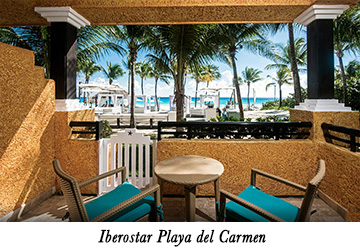 At Dressel Divers in Cozumel's Iberostar Hotel, the dive shop briefing was mass confusion, and wet divers wandered in and out of the disorganized pre-dive briefing. The shop representative was unable to show us the drying room because someone had run off with the key. Registration was complicated and disorganized. Right off the bat, I knew why I preferred smaller operations.
At Dressel Divers in Cozumel's Iberostar Hotel, the dive shop briefing was mass confusion, and wet divers wandered in and out of the disorganized pre-dive briefing. The shop representative was unable to show us the drying room because someone had run off with the key. Registration was complicated and disorganized. Right off the bat, I knew why I preferred smaller operations.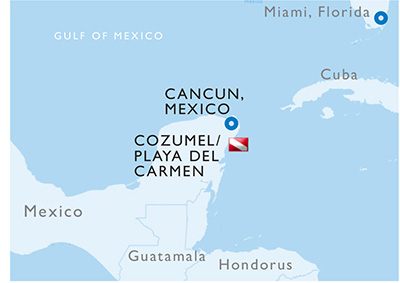 At Palancar Gardens I encountered several
scrawled and white-spotted filefish, queen and oceanic
triggerfish, trunkfish, porcupine fish, and a
spotted scorpionfish while eyeing several four-foot
barracuda, and under an overhang, a nurse shark. I
encountered an immense blue parrotfish, and queen and French angels were common.
While this was a very fishy dive, Yucab Reef was not as much, but the goal there
was to spot the endemic and rare splendid toadfish -- and I did, even spotting one
outside its hole during the day.
At Palancar Gardens I encountered several
scrawled and white-spotted filefish, queen and oceanic
triggerfish, trunkfish, porcupine fish, and a
spotted scorpionfish while eyeing several four-foot
barracuda, and under an overhang, a nurse shark. I
encountered an immense blue parrotfish, and queen and French angels were common.
While this was a very fishy dive, Yucab Reef was not as much, but the goal there
was to spot the endemic and rare splendid toadfish -- and I did, even spotting one
outside its hole during the day.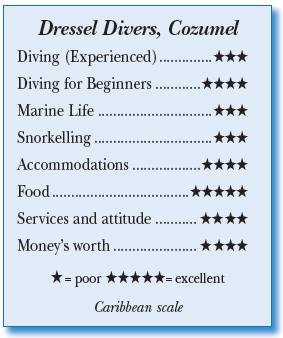 Still, this is Mexico. Drink only bottled water. Avoid uncooked vegetables and salads. Despite cautions, 20 of our group of 30 contracted Montezuma's revenge with varying severity. As a physician, I came prepared with Rifaximin, an antibiotic specifically for the prevention or treatment of travelers' gastro-enteritis. (If you're traveling to Mexico, get a prescription for this or my second choice, Bactrim, from your physician). A double dose of Rifaximin stopped the worst symptoms in four hours, and then, one twice a day seemed to control it enough to allow one to dive until it ran its course. I kept handing out these tablets until we were getting on the plane to leave.
Still, this is Mexico. Drink only bottled water. Avoid uncooked vegetables and salads. Despite cautions, 20 of our group of 30 contracted Montezuma's revenge with varying severity. As a physician, I came prepared with Rifaximin, an antibiotic specifically for the prevention or treatment of travelers' gastro-enteritis. (If you're traveling to Mexico, get a prescription for this or my second choice, Bactrim, from your physician). A double dose of Rifaximin stopped the worst symptoms in four hours, and then, one twice a day seemed to control it enough to allow one to dive until it ran its course. I kept handing out these tablets until we were getting on the plane to leave.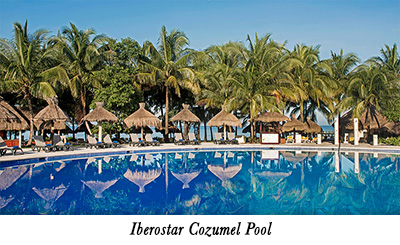 But don't get a room in Building 15 near the entertainment stage at the Tucan Iberostar. During evening performances, it is impossible to sleep due to the music volume; the base vibrates your bed. Performances lasted until well after 11 p.m., which drove my dive buddy nuts, and he had to get another room.
But don't get a room in Building 15 near the entertainment stage at the Tucan Iberostar. During evening performances, it is impossible to sleep due to the music volume; the base vibrates your bed. Performances lasted until well after 11 p.m., which drove my dive buddy nuts, and he had to get another room.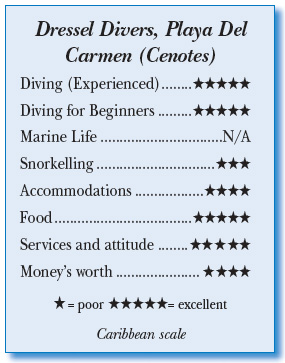 Chikin-ha cenote was selected for our group,
since several, including children, were only snorkelers
and the cenote had a large enough opening
for snorkeling. Our guide said she was very attentive
to the anxiety levels and possible claustrophobia-
related diver panic, but they have had no
events. Occasionally people gear up, then, after
looking at the narrow entrance and imagining diving
underground, decide it's not for them.
Chikin-ha cenote was selected for our group,
since several, including children, were only snorkelers
and the cenote had a large enough opening
for snorkeling. Our guide said she was very attentive
to the anxiety levels and possible claustrophobia-
related diver panic, but they have had no
events. Occasionally people gear up, then, after
looking at the narrow entrance and imagining diving
underground, decide it's not for them.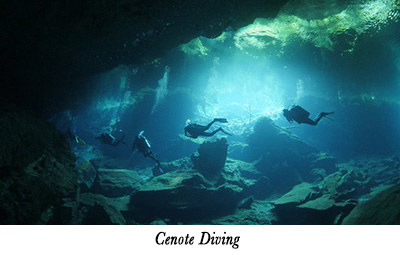 Every year, between May and September, whale sharks migrate in great numbers along the coast of the Yucatan. The final part of our trifecta was the whale shark snorkel at Isla Mujeres, after a pickup at 6 a.m. and a two-hour drive. I must admit to passing on this one, having seen hundreds of whale sharks during my world travels. And, especially after hearing reports of a four-hour round trip in a van to the boat, a four-hour round trip in an open boat on the open ocean, and no sun shade. I took the other option offered and went back for another day of cenote diving. But, the snorkelers who did swim with whale sharks, a dozen animals one day and six the next day, collected great stills, video clips and memories. To one diver, it was the greatest large animal encounter she'd ever had, spending almost an hour in the water with the massive animals. However, one girl, who had a total of 20 minutes in the water with whale sharks, and eight hours of transit, sunburn, seasickness and hassle, said "Been there, done that."
Every year, between May and September, whale sharks migrate in great numbers along the coast of the Yucatan. The final part of our trifecta was the whale shark snorkel at Isla Mujeres, after a pickup at 6 a.m. and a two-hour drive. I must admit to passing on this one, having seen hundreds of whale sharks during my world travels. And, especially after hearing reports of a four-hour round trip in a van to the boat, a four-hour round trip in an open boat on the open ocean, and no sun shade. I took the other option offered and went back for another day of cenote diving. But, the snorkelers who did swim with whale sharks, a dozen animals one day and six the next day, collected great stills, video clips and memories. To one diver, it was the greatest large animal encounter she'd ever had, spending almost an hour in the water with the massive animals. However, one girl, who had a total of 20 minutes in the water with whale sharks, and eight hours of transit, sunburn, seasickness and hassle, said "Been there, done that." Divers Compass: Roundtrip from North America on American Airlines, all transfers, all diving, all-inclusive hotel -- just short of 5-star hotel service at the two all-inclusive Iberostars, where it was all you could eat and drink with free entertainment and activities - was $3900 / person, group rate. . . . .Putting this trip together is complicated, so get a travel agent. Amy at Caradonna did a great job (800-328-2288)
Divers Compass: Roundtrip from North America on American Airlines, all transfers, all diving, all-inclusive hotel -- just short of 5-star hotel service at the two all-inclusive Iberostars, where it was all you could eat and drink with free entertainment and activities - was $3900 / person, group rate. . . . .Putting this trip together is complicated, so get a travel agent. Amy at Caradonna did a great job (800-328-2288) 